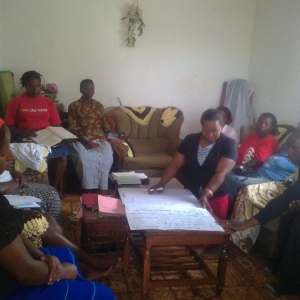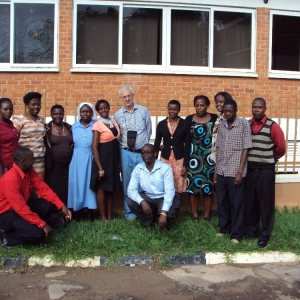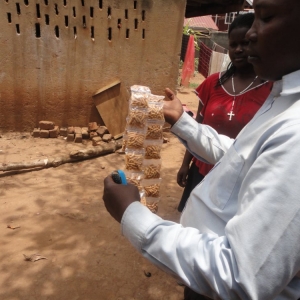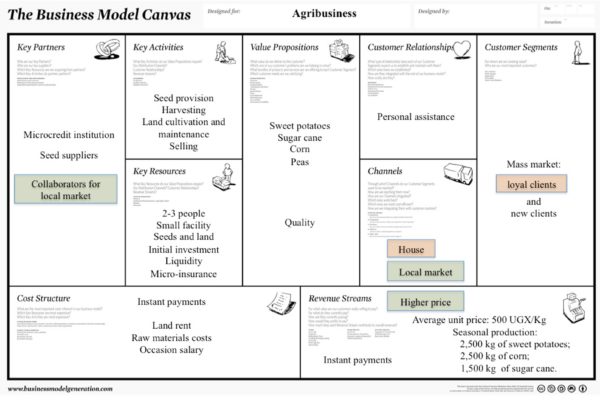The implementation of the model for an agribusiness
The Business Model Canvas has been adopted to analyse and reproduce several business models operating in Uganda.
1. Description of the business
More precisely, the case study considered in this report concerns an agribusiness producing sweet potatoes, sugar cane, corn and peas.
The business model canvas reported in Fig. 1 represents the definition of a business, which has been realised from the analysis of a successful business, managed by Cacoda Poe.
The aim of this business model canvas consists in defining and describing the successful factors characterising an agribusiness, started in 2002 thanks to the granted loans of Wekembe of about 200,000 Ugandan schillings. Actually, the entrepreneur has received the fifth loan for 1 million Ugandan schillings. The business is undertaken principally by a person, supported by his relatives and reaching at least annual revenues for 8 millions Ugandan schillings and profits for 5 millions Ugandan schillings in a normal year.
2. Building blocks description
Customer segments
The customer segment identified for this agribusiness is the mass market, because the clients of these crops are common village people, not discriminated by ages, gender and occupation. Buyers are considered also users, but it is necessary to consider also some users, as children, who do not personally buy these products but consume them.
Among this mass-market segment, loyal and new clients are identified. In particular, loyal clients are consumers who personally buy products at farmer’s home because they have good product awareness and they usually purchase frequently.
This business has a good potential for growth, due to the typology of the products sold, which are bought for daily sustenance by common people. Moreover, some seasons, important clients purchase the whole crops.
Value propositions
The agribusiness concerns the production of sweet potatoes, sugar cane, corn and peas. The production of peas realise an insignificant amount compared to other cultures. All these crops occur twice per year, so every 2 seasons the farmers has to harvest them.
The personal commitment in the cultivation of these products and the adoption of natural processes allow the farmer to be reached by village people for the high quality of his crops. In fact, the facility and land location of the farmer are not in an easy area to be reached, because of the disconnected roads and the low visibility.
Clients buy these products thanks to their quite great availability and for the excellence of their production process.
Channels
As mentioned before, most of the purchases occur at farmer’s house, due to the difficulty to reach local markets. Loyal clients, who have a good awareness of this business, reach him at his property and purchase products by paying instantaneously.
The local market is a potential channel, which might be adopted by the entrepreneur to increase sales and establish a higher price. The most important weakness concerns the greater costs the farmer has to support in order to reach local markets. In fact, the farmer might evaluate if the higher profit margins ensured by purchases at local markets, thoroughly cover the high costs necessary to reach neighbouring areas. On the contrary, the entrepreneur may develop collaborations with one or more partners, who usually reach local market to share the expenses. The difficulty in roads access and the high costs in transportation constitute a limit for people who want to reach local markets to purchase products.
Customer relationships
Personal assistance to all clients is ensured during the purchase process. Customers directly interact with the farmer, who is also the seller of crops, and in this way they can keep an informal way of communication. People can ask information about products and they can also assist to the harvesting, in order to control the naturalness of the process. The direct contact strengths the continuity of the relationships among producer and clients and this ensures a better satisfaction of customer needs over the long term.
The farmer might ensure this way of interaction also at local markets through a direct control of the selling process. Otherwise, if the farmer assigns the task to a collaborator, he will ensure about the carefulness and the interest this person express towards purchasers, in order to increase the number of relationships to keep and grow.
Revenue streams
As mentioned above, clients pay instantaneously for their purchases. In average, by considering crops realised at the single season, it is possible to identify a production of sweet potatoes and corn for 2,500 kilograms each and the production of sugar cane for about 3,000 kilograms. These crops ensure annual revenues nearby 8 millions Ugandan schillings and profit about 5 millions Ugandan schillings.
Approximately, the unit-selling price for each kilogram of product is around 500 Ugandan schillings. As reported above, the unit-selling price established for local market might ensure higher profit margins because clients who purchase in those areas have a higher purchasing power and more financial resources to spend.
Key resources
The agribusiness needs the continuous commitment of at least 2 or 3 people who work full time on the land, due to the numerous activities to develop and physical efforts required to better run the business. The additional collaborators necessary to support the entrepreneur in his activities might be components of his family. By doing this, the farmer will save additional labour costs instead of paying salaries and give them the essential sustainment such as food and beverage.
Seeds and a 4 hectares land are required to ensure the quantity of crops mentioned above. The farmer also needs a small facility to use to storage the products he harvests, before the selling to final clients. During some seasons, clients purchase the entire crops and in these situations the storehouse might not be useful. Most of the time, clients do not buy the whole crops and the warehouse is necessary to storage products between the harvesting and the selling.
Microcredit institutions ensure granted loans to entrepreneurs to allow them to start their business and promote their enlargement. In this specific business, financial resources are required to ensure its sustainability because the inflows and outflows occur in different moments. More precisely, the payments for seeds and land occur at the beginning of the season, in order to allow the farmer to start the cultivation of products. During all the season, he has to survive thanks to personal savings or granted loans of microcredit institutions. The revenues occur at the end of the season, after the harvesting and the selling of products. This is the moment in which the entrepreneur receive inflow from his activity. For this reason, the availability of cash for the farmer is necessary to let him work and his family survive.
Beyond the risk that the entrepreneur has to support between the disbursement for suppliers and the receiving of payments, there is the threat to lose the whole crops due to disasters, such as violent storms or aggressive parasites. In order to face these ruinous losses, the farmers might secure the business by paying a micro-insurance, which could ensure him not to lose the entire revenues for that season.
Key partners
In order to overcome the problem concerning the different periods of time the entrepreneur makes and receives payments, the sustenance from microcredit institutions is essential. These partners help entrepreneurial people in developing countries to dispose of all necessities to keep their activities sustainable in the long term and support them in the promotion of their business.
As mentioned above, every 2 seasons the farmer has to seed to let the crop grow. This necessary activity requires the provision of seeds from specific suppliers. To allow the continuity of the agricultural process, it is necessary to keep long and strong relationships with them, also to benefit from a trustworthy relation.
Other important partners are collaborators useful to share high costs associated to local market selling activity. Due to the incapacity to support all the additional expenses to adopt another distribution channel, the entrepreneur has to find collaborators willing to share these kind of costs.
Key activities
Each season the new production process starts. The first activity consists in sowing seeds of sweet potatoes, sugar cane, corn and peas. After their growth, the farmer proceeds with the harvesting, as displayed for sweet potatoes in Fig. 2.
Before the seeding and after the harvesting, the land needs maintenance. The farmer has to move, fertilise and irrigate the land in order to promote again the rise of mineral salts and fruitful crops. The business concerning land-working activities requires continuous commitment in property conservation in order to ensure unceasing harvests.
Finally, the process ends with the sale of all products harvested by the farmer and his employees.
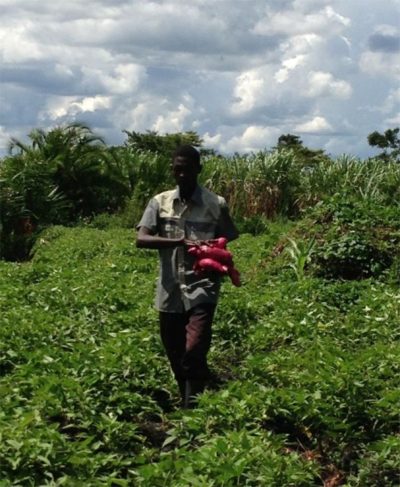
Fig. 2: The harvesting of sweet potatoes
Cost structure
The main cost item for this business is the one concerning the provision of seeds. This expense consists in 1,5 millions Ugandan schillings per season and 3 million Ugandan schillings for the annual provision.
Each year, the entrepreneur pays about 10,000 Ugandan schillings for renting the 4 hectares land. This amount is considered insignificant compared to the whole amount of costs that incur in one normal year.
Moreover, labour costs, as the entrepreneur salary, are not counted in the cost structure due to their variable amounts and difficulty in counting it for the farmer. For this reason, it is necessary to consider salaries as part of revenues.
As mentioned before, the outflow for raw materials has to be compensated by liquidity in order to overcome not profitable months, between the beginning and the end of each season.



